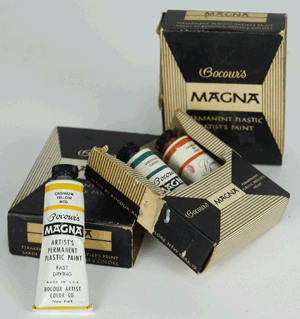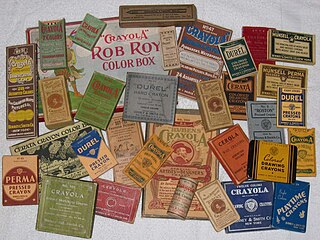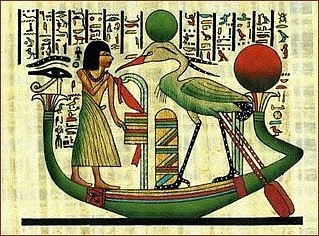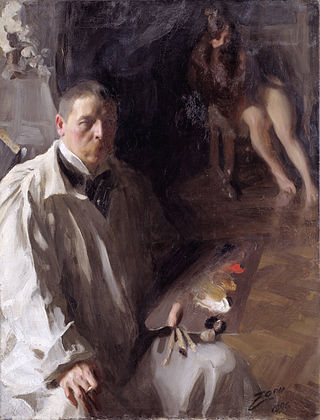
Acrylic paint is a fast-drying paint made of pigment suspended in acrylic polymer emulsion and plasticizers, silicone oils, defoamers, stabilizers, or metal soaps. Most acrylic paints are water-based, but become water-resistant when dry. Depending on how much the paint is diluted with water, or modified with acrylic gels, mediums, or pastes, the finished acrylic painting can resemble a watercolor, a gouache, or an oil painting, or it may have its own unique characteristics not attainable with other media.

Oil painting is a painting method involving the procedure of painting with pigments with a medium of drying oil as the binder. It has been the most common technique for artistic painting on canvas, wood panel or copper for several centuries, spreading from Europe to the rest of the world. The advantages of oil for painting images include "greater flexibility, richer and denser colour, the use of layers, and a wider range from light to dark". But the process is slower, especially when one layer of paint needs to be allowed to dry before another is applied.

Paint is a material or mixture that, when applied to a solid material and allowed to dry, adds a film-like layer. As art, this is used to create an image or images known as a painting. Paint can be made in many colors and types. Most paints are either oil-based or water-based, and each has distinct characteristics.

A crayon is a stick of pigmented wax used for writing or drawing. Wax crayons differ from pastels, in which the pigment is mixed with a dry binder such as gum arabic, and from oil pastels, where the binder is a mixture of wax and oil.

Gouache, body color, or opaque watercolor is a water-medium paint consisting of natural pigment, water, a binding agent, and sometimes additional inert material. Gouache is designed to be opaque. Gouache has a long history, having been used for at least twelve centuries. It is used most consistently by commercial artists for posters, illustrations, comics, and other design work.

Crayola LLC, formerly the Binney & Smith Company, is an American manufacturing and retail company specializing in art supplies. It is known for its brand Crayola and best known for its crayons. The company is headquartered in Forks Township, Pennsylvania in the Lehigh Valley region of the state. Since 1984, Crayola has been a wholly owned subsidiary of Hallmark Cards.

Watercolor or watercolour, also aquarelle, is a painting method in which the paints are made of pigments suspended in a water-based solution. Watercolor refers to both the medium and the resulting artwork. Aquarelles painted with water-soluble colored ink instead of modern water colors are called aquarellum atramento by experts. However, this term has now tended to pass out of use.

Magna is the brand name of an acrylic resin paint, developed by Leonard Bocour and sold by Bocour Artist Colors, Inc. in 1947. It is somewhat different from modern acrylic paint, as it is composed of pigments ground in an acrylic resin brought into emulsion through the use of solvents. Magna paint has more of a shine to it than most modern acrylic paint, a glossier finish. In 1960, Bocour Artist Colors developed a water-borne acrylic paint named Aqua-Tec. Modern acrylic paint is water-soluble, while Magna is miscible with turpentine or mineral spirits, though both can dry rapidly to a matte or glossy finish. It was used by artists such as Barnett Newman, Morris Louis, and Roy Lichtenstein. Roy Lichtenstein used magna with oil paints.
Sennelier is a French manufacturing company of art materials, mostly famous for its hand selected pigments. The company produces a wide range of paint products, including acrylic, oil, watercolor, gouache, oil and soft pastel, india ink, tempera, and other media.
A glaze is a thin transparent or semi-transparent layer on a painting which modifies the appearance of the underlying paint layer. Glazes can change the chroma, value, hue and texture of a surface. Glazes consist of a great amount of binding medium in relation to a very small amount of pigment. Drying time will depend on the amount and type of paint medium used in the glaze. The medium, base, or vehicle is the mixture to which the dry pigment is added. Different media can increase or decrease the rate at which oil paints dry.

A wash is a term for a visual arts technique resulting in a semi-transparent layer of colour. A wash of diluted ink or watercolor paint applied in combination with drawing is called pen and wash, wash drawing, or ink and wash. Normally only one or two colours of wash are used; if more colours are used the result is likely to be classified as a full watercolor painting.

Automotive paint is paint used on automobiles for both protective and decorative purposes. Water-based acrylic polyurethane enamel paint is currently the most widely used paint for reasons including reducing paint's environmental impact.
The following is a partial timeline of Crayola's history. It covers the Crayola brand of marking utensils, as well as the history of Binney & Smith, the company that created the brand and is currently a subsidiary of Hallmark Cards known as Crayola LLC.
Acrylic painting techniques are different styles of manipulating and working with polymer-based acrylic paints. Acrylics differ from oil paints in that they have shorter drying times and are soluble in water. These types of paint eliminate the need for turpentine and gesso, and can be applied directly onto canvas. Aside from painting with concentrated color paints, acrylics can also be watered down to a consistency that can be poured or used for glazes.

Painting is a visual art, which is characterized by the practice of applying paint, pigment, color or other medium to a solid surface. The medium is commonly applied to the base with a brush, but other implements, such as knives, sponges, and airbrushes, may be used.

Since the introduction of Crayola drawing crayons by Binney & Smith in 1903, more than two hundred colors have been produced in a wide variety of assortments. The line has undergone several major revisions, notably in 1935, 1949, 1958, and 1990. Numerous specialty crayons have also been produced, complementing the basic Crayola assortment.

Watercolor paper is paper or substrate onto which an artist applies watercolor paints, pigments, or dyes. Many types of watercolour papers that are manufactured for the use of watercolors are currently available. Watercolor paper can be made of wood pulp exclusively, or mixed with cotton fibers. Pure cotton watercolor paper is also used by artists, though it typically costs more than pulp-based paper. It is also available as an acid-free medium to help its preservation.

The conservation and restoration of paintings is carried out by professional painting conservators. Paintings cover a wide range of various mediums, materials, and their supports. Painting types include fine art to decorative and functional objects spanning from acrylics, frescoes, and oil paint on various surfaces, egg tempera on panels and canvas, lacquer painting, water color and more. Knowing the materials of any given painting and its support allows for the proper restoration and conservation practices. All components of a painting will react to its environment differently, and impact the artwork as a whole. These material components along with collections care will determine the longevity of a painting. The first steps to conservation and restoration is preventive conservation followed by active restoration with the artist's intent in mind.

Paint mixing is the practice of mixing components or colors of paint to combine them into a working material and achieve a desired hue. The components that go into paint mixing depend on the function of the product sought to be produced. For example, a painter of portraits or scenery on a canvas may be seeking delicate hues and subtle gradiations, while the painter of a house may be more concerned with durability and consistency of colors in paints presented to customers, and the painter of a bridge or a ship may have the weatherability of the paint as their primary concern.
Colart, or the Colart Group, is a large international supplier of art materials, with subsidiaries and brands such as Winsor & Newton, Liquitex and Lefranc & Bourgeois. The group's head office is situated in London.














